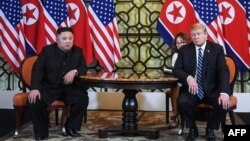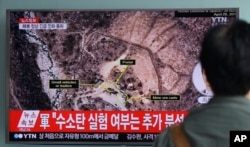Christy Lee of the VOA Korean Service contributed to this report.
WASHINGTON — By implying on Fox TV the U.S. knew of five North Korean sites, U.S. President Donald Trump may have sent a message to North Korean leader Kim Jong Un that the U.S. is pursuing a “big deal” approach toward denuclearization, experts say.
“He wanted to get rid of one or two sites,” said Trump while speaking about Kim during an interview on Fox News May 19.
“What about the other three sites?” Trump said on Fox. “That’s no good. If we’re going to make a deal, let’s make a real deal.”
Trump did not identify on air which five nuclear sites he was referring to.
Trump said Kim previously offered to close down the Yongbyon Nuclear Scientific Research Center.
At the Hanoi summit in March, Trump called on Kim to “fully dismantle North Korea’s nuclear infrastructure” by handing him a list of demands written on a piece of paper reviewed by Reuters at the time. Other demands listed included dismantling “ballistic missiles, launchers, and associated facilities” as well as a “chemical and biological warfare program.”
Kim refused this all-or-nothing or “big deal” approach that called for denuclearization all at once. North Korea has favored a phase-out approach of dismantling its nuclear weapons program in an incremental fashion. Kim responded to Trump by asking that all sanctions be lifted. The summit quickly ended without any nuclear deal and denuclearization talks between Washington and Pyongyang have been stalled since.
Which is why Trump’s “five sites” allusion is seen by some experts as a way to tell Kim that he still stands by his comprehensive “big deal” approach toward denuclearization that he took at the Hanoi summit.
“I think he was making it very clear [about] the U.S. position,” said Joseph DeTrani, a former special envoy for nuclear talks with North Korea. “[Trump] wants that ‘big deal’ approach.”
Gary Samore, the White House coordinator for arms control and weapons of mass destruction during the Obama administration, said, “The U.S. is saying to North Korea, ‘we are not satisfied with dismantlement of Yongbyon.’” He continued, “That is not a sufficient step. We need to see all the facilities that produce fissile materials to be closed down and dismantled.”
What five sites?
Still, the specific number of nuclear sites Trump suggested has confounded some experts.
Ken Gause, director of Adversary Analytics Program at the CNA, a research organization, said, “The fact that he mentioned five is a bit perplexing.” He continued, “It’s kind of hard to figure out what would be gained by that, other than potentially signaling to North Korea … we want you to give up a significant chunk of what you have.”
Christopher Hill, a chief negotiator with North Korea during the George W. Bush administration, said, “It’s the first time a number has been put out there.” He added, “This speaks to the fact that I don’t think President Trump knows the difference between intelligence and information.”
Nuclear experts are also wondering what Trump meant by five nuclear sites: Did he mean five locations that could hold several nuclear facilities? Or, did he mean five individual facilities? Or five test sites?
Michael Elleman, a senior fellow at the International Institute for Strategic Studies, said, “From [Trump’s] brief comments, it is not possible to know precisely what he meant by five nuclear sites.” He continued, “Does this include the test sites or research facilities?”
Olli Heinonen, former deputy director general of the International Atomic Energy Agency (IAEA), said, “Some sites could have several facilities, which are a matter of concern.”
North Korea has approximately thirty nuclear facilities that have different nuclear capabilities located in sites scattered around the country including facilities in and around the Yongbyon nuclear complex, according to U.S. and South Korean intelligence agencies.
“Manufacturing of components wherever they are, that site needs to be closed,” said Heinonen. “And then putting the nuclear warheads together -- assembly -- that needs to be closed.”
Jeffrey Lewis, director of the East Asia Nonproliferation Program at California’s Middlebury Institute of International Studies, said if Trump meant areas where several nuclear-related facilities are located, “I imagine that the administration had a priority list of five sites they wanted closed.” He added, “That would include not just the Yongbyon Nuclear Research Center (which has many facilities) but also additional uranium enrichment sites such as Kangson.”
The Yongbyon nuclear center is where facilities to enrich uranium and the country’s only suspected facility for reprocessing plutonium are located. Reprocessing plutonium and enriching uranium are the two pathways for developing nuclear weapons.
North Korea is also believed to have a nuclear site at Kangson, a suspected uranium enrichment plant that Lewis and his team located based on high-resolution images pieced together.
Lewis said, “North Korea has many, many more nuclear sites than just five.” He believes other possible nuclear sites are located in Hagap, Pyongsan, and Pakchon. Hagap in the country’s North Hwanghae Province is a site for unidentified facilities that could potentially have an underground reprocessing facility. Pyongsan, which is also in North Hwanghae Province, is suspected to be a site for uranium core concentration plants and mines. Pakchon, in North Pyongan Province, is reportedly a site of North Korea’s key uranium mine.
Additionally, North Korea has its only nuclear test site at Punggye-ri and the Sohae missile launch site in Tongchang-ri.









